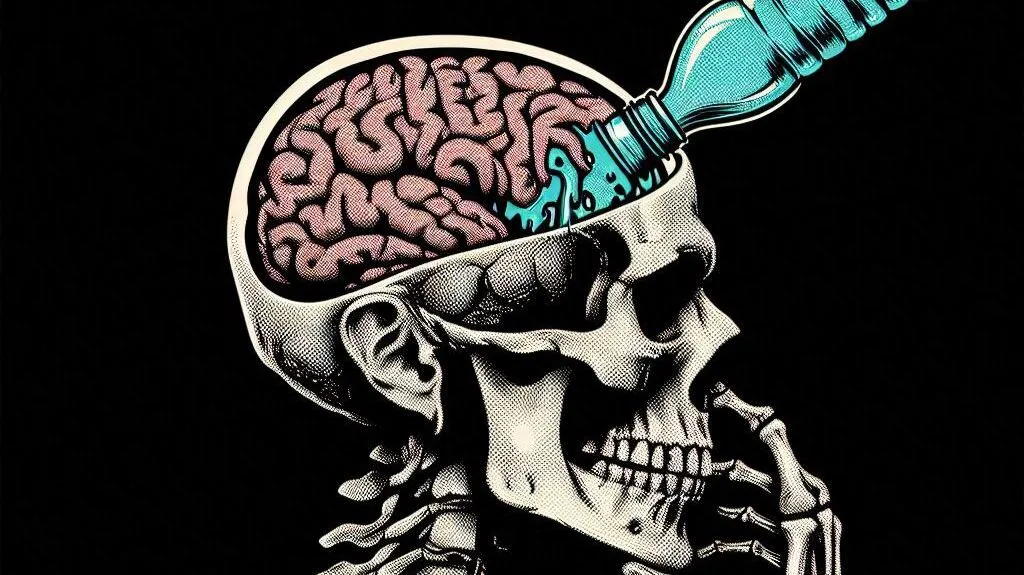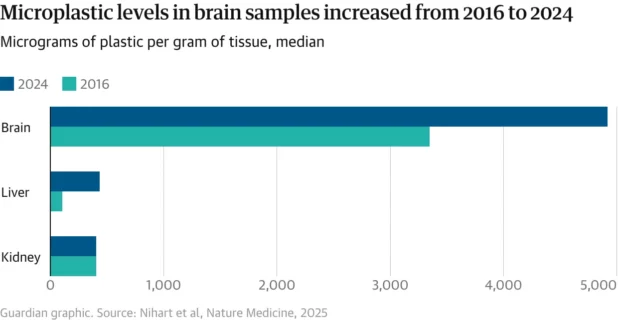The human brain:
—had 7-30 times more accumulation of microparticles (MPs) than the liver or kidney (organs with previously documented high propensity)
—from people with dementia had 5X accumulation of MPs compared with non-dementia
—there was a marked increase of accumulation…— Eric Topol (@EricTopol) February 3, 2025
Covered here, with relevant background and another new study on blood clots in the brain after microplastics https://t.co/15SGIx6rgL pic.twitter.com/orIy82Tdmq
— Eric Topol (@EricTopol) February 3, 2025
Microplastics actually should work their way through your body pretty quickly, in theory.
But for one, the brain can build up toxins and hold them for much longer than the rest of your organs, and further, people are consuming so many microplastics that they just constantly have them in their bodies.
To be clear, this completely changes the chemical makeup of your body, it affects all of your systems, and in particular, affects your hormonal system, making you fat and gay.
The exponential rise in microplastic pollution over the past 50 years may be reflected in increasing contamination in human brains, according to a new study.
It found a rising trend in micro- and nanoplastics in brain tissue from dozens of postmortems carried out between 1997 and 2024. The researchers also found the tiny particles in liver and kidney samples.
The human body is widely contaminated by microplastics. They have also been found in blood, semen, breast milk, placentas and bone marrow. The impact on human health is largely unknown, but they have been linked to strokes and heart attacks.
The scientists also found that the concentration of microplastics was about six times higher in brain samples from people who had dementia. However, the damage dementia causes in the brain would be expected to increase concentrations, the researchers said, meaning no causal link should be assumed.
…
The new research, published in the journal Nature Medicine, analysed samples of brain, liver and kidney tissues from 28 people who died in 2016 and 24 who died in 2024 in New Mexico. Microplastic concentration was much higher in the brain tissue. It was also higher in brain and liver samples from 2024, compared with those from 2016.
The scientists extended the analysis with brain tissue samples from people who had died between 1997 and 2013 on the US east coast. The data showed an increasing trend in microplastic contamination of brains from 1997 to 2024.
The most common plastic found was polyethylene, which is used in plastic bags and food and drink packaging. It made up 75% of the total plastic on average. The particles in the brain were mostly nanoscale shards and flakes of plastic. The plastic concentrations in the organs were not influenced by the age of the person at death, or the cause of death, their sex or their ethnicity.
This is a legitimate crisis, which should be treated as a crisis.
But instead, we get endless bullshit about viruses and global warming. There is no attempt to address the plastic issue, because the large corporations that fund the government, and which government employees are invested in, could not make any money off of addressing the plastic problem.
These findings are from a study in @NatureMedicine which applied gas chromatography–mass spectrometry with visualization methods to assess the relative distribution of microplastics in major organ systems. https://t.co/0LeWpOhy4B 2/10 pic.twitter.com/fVLWiGctMA
— Nicholas Fabiano, MD (@NTFabiano) February 3, 2025
In controlled cell culture and animal exposure studies, MNPs exacerbate disease or drive toxic outcomes, but at concentrations with unclear relevance to human exposures and body burdens. 4/10
— Nicholas Fabiano, MD (@NTFabiano) February 3, 2025
In this study, brain tissues were found to harbor 7–30 times higher proportions of MNPs compared to plastics in the liver or kidney. 6/10 pic.twitter.com/xvais2ZVE3
— Nicholas Fabiano, MD (@NTFabiano) February 3, 2025
Plastic concentrations in these decedent tissues were not influenced by age, sex, race/ethnicity or cause of death; the time of death (2016 versus 2024) was a significant factor, with increasing MNP concentrations over time in both liver and brain samples (P = 0.01). 8/10
— Nicholas Fabiano, MD (@NTFabiano) February 3, 2025
Overall, these results highlight a critical need to better understand the routes of exposure, uptake and clearance pathways and potential health consequences of plastics in human tissues, particularly in the brain. 10/10
— Nicholas Fabiano, MD (@NTFabiano) February 3, 2025

